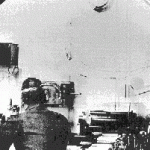Equipment:
The Titanic’s “wireless” equipment was the most powerful in use at the time. The main transmitter was a rotary spark design, powered by a 5 kW motor generator, fed from the ship’s lighting circuit. The equipment operated into a 4 wire antenna suspended between the ship’s 2 masts, some 250 feet above the sea.
There was also a battery powered emergency transmitter and a separate motor generator in the room next door. The equipment’s guaranteed working range was 250 miles, but communications could be maintained for up to 400 miles during daylight and up to 2,000 miles at night.
 Assistant Radio Operator Harold Bride at the “Marconi Wireless” aboard the Titanic
Assistant Radio Operator Harold Bride at the “Marconi Wireless” aboard the Titanic
Location of the “Marconi Room”:
The “Marconi Room” was situated on the Boat-Deck (i.e.: the same deck as the Bridge), at the after end of the superstructure containing the Bridge and Officer’s quarters – it was about 40 feet aft from the Bridge, connected via the corridor which ran down the port side of the Officer’s quarters.
The “Marconi Room” was in the centre of the accommodation – it did not have an outside facing porthole. Natural light was provided via a skylight in the deckhead (ceiling).
The Radio Operators sleeping accommodation was in a separate room to starboard of the “Marconi Room” – connected to the operating room by an interconnecting door. The Radio Operators shared the Officer’s toilet/washroom facilities across the corridor.
The “Marconi Room” was connected to the ship’s 50 line telephone exchange. However, it appears that there was no direct telephone connection to the Bridge.
This problem was rectified on Titanic’s sister ships ‘Olympic’ and ‘Britannic’ after the Titanic disaster – a speaking tube was installed which connected the “Marconi Room” to the Bridge.